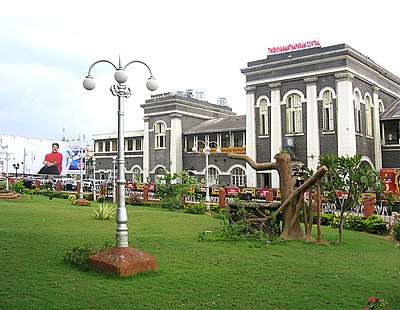Thiruvananthapuram–Nagercoil–Kanyakumari line
The Thiruvananthapuram–Nagercoil–Kanyakumari line is a line in the Southern Railway zone of Indian Railways. It connects the cities Thiruvananthapuram and Nagercoil. The railway opened on 15 April 1979.
| Thiruvananthapuram–Kanyakumari line | |||||||||||||||||||||||||||||||||||||||||||||||||||||||||||||||||||||||||||||||||||||||||||||||||||||||||||||||||||||||||||||||||||||||||||||||||||||||||||||||||||||||||||||||||||||||||||||||||||
|---|---|---|---|---|---|---|---|---|---|---|---|---|---|---|---|---|---|---|---|---|---|---|---|---|---|---|---|---|---|---|---|---|---|---|---|---|---|---|---|---|---|---|---|---|---|---|---|---|---|---|---|---|---|---|---|---|---|---|---|---|---|---|---|---|---|---|---|---|---|---|---|---|---|---|---|---|---|---|---|---|---|---|---|---|---|---|---|---|---|---|---|---|---|---|---|---|---|---|---|---|---|---|---|---|---|---|---|---|---|---|---|---|---|---|---|---|---|---|---|---|---|---|---|---|---|---|---|---|---|---|---|---|---|---|---|---|---|---|---|---|---|---|---|---|---|---|---|---|---|---|---|---|---|---|---|---|---|---|---|---|---|---|---|---|---|---|---|---|---|---|---|---|---|---|---|---|---|---|---|---|---|---|---|---|---|---|---|---|---|---|---|---|---|---|---|
 Thiruvananthapuram Central Station main building | |||||||||||||||||||||||||||||||||||||||||||||||||||||||||||||||||||||||||||||||||||||||||||||||||||||||||||||||||||||||||||||||||||||||||||||||||||||||||||||||||||||||||||||||||||||||||||||||||||
| Overview | |||||||||||||||||||||||||||||||||||||||||||||||||||||||||||||||||||||||||||||||||||||||||||||||||||||||||||||||||||||||||||||||||||||||||||||||||||||||||||||||||||||||||||||||||||||||||||||||||||
| Type | Regional rail Light rail | ||||||||||||||||||||||||||||||||||||||||||||||||||||||||||||||||||||||||||||||||||||||||||||||||||||||||||||||||||||||||||||||||||||||||||||||||||||||||||||||||||||||||||||||||||||||||||||||||||
| System | Electrified | ||||||||||||||||||||||||||||||||||||||||||||||||||||||||||||||||||||||||||||||||||||||||||||||||||||||||||||||||||||||||||||||||||||||||||||||||||||||||||||||||||||||||||||||||||||||||||||||||||
| Status | Operational | ||||||||||||||||||||||||||||||||||||||||||||||||||||||||||||||||||||||||||||||||||||||||||||||||||||||||||||||||||||||||||||||||||||||||||||||||||||||||||||||||||||||||||||||||||||||||||||||||||
| Locale | Kerala Tamilnadu | ||||||||||||||||||||||||||||||||||||||||||||||||||||||||||||||||||||||||||||||||||||||||||||||||||||||||||||||||||||||||||||||||||||||||||||||||||||||||||||||||||||||||||||||||||||||||||||||||||
| Termini | Thiruvananthapuram Central (TVC) Kanyakumari (CAPE) | ||||||||||||||||||||||||||||||||||||||||||||||||||||||||||||||||||||||||||||||||||||||||||||||||||||||||||||||||||||||||||||||||||||||||||||||||||||||||||||||||||||||||||||||||||||||||||||||||||
| Stations | 16 | ||||||||||||||||||||||||||||||||||||||||||||||||||||||||||||||||||||||||||||||||||||||||||||||||||||||||||||||||||||||||||||||||||||||||||||||||||||||||||||||||||||||||||||||||||||||||||||||||||
| Services | 1 | ||||||||||||||||||||||||||||||||||||||||||||||||||||||||||||||||||||||||||||||||||||||||||||||||||||||||||||||||||||||||||||||||||||||||||||||||||||||||||||||||||||||||||||||||||||||||||||||||||
| Website | Southern Railway | ||||||||||||||||||||||||||||||||||||||||||||||||||||||||||||||||||||||||||||||||||||||||||||||||||||||||||||||||||||||||||||||||||||||||||||||||||||||||||||||||||||||||||||||||||||||||||||||||||
| Operation | |||||||||||||||||||||||||||||||||||||||||||||||||||||||||||||||||||||||||||||||||||||||||||||||||||||||||||||||||||||||||||||||||||||||||||||||||||||||||||||||||||||||||||||||||||||||||||||||||||
| Opened | 1979[1] | ||||||||||||||||||||||||||||||||||||||||||||||||||||||||||||||||||||||||||||||||||||||||||||||||||||||||||||||||||||||||||||||||||||||||||||||||||||||||||||||||||||||||||||||||||||||||||||||||||
| Owner | Southern Railway zone | ||||||||||||||||||||||||||||||||||||||||||||||||||||||||||||||||||||||||||||||||||||||||||||||||||||||||||||||||||||||||||||||||||||||||||||||||||||||||||||||||||||||||||||||||||||||||||||||||||
| Operator(s) | Thiruvananthapuram | ||||||||||||||||||||||||||||||||||||||||||||||||||||||||||||||||||||||||||||||||||||||||||||||||||||||||||||||||||||||||||||||||||||||||||||||||||||||||||||||||||||||||||||||||||||||||||||||||||
| Rolling stock | WAP-1, WAP-4 electric locos; WDS-6, WDM-2, WDM-3A, WDP-4 and WDG-3A, WDG-4 | ||||||||||||||||||||||||||||||||||||||||||||||||||||||||||||||||||||||||||||||||||||||||||||||||||||||||||||||||||||||||||||||||||||||||||||||||||||||||||||||||||||||||||||||||||||||||||||||||||
| Events | |||||||||||||||||||||||||||||||||||||||||||||||||||||||||||||||||||||||||||||||||||||||||||||||||||||||||||||||||||||||||||||||||||||||||||||||||||||||||||||||||||||||||||||||||||||||||||||||||||
| Electrification | 2012[2] | ||||||||||||||||||||||||||||||||||||||||||||||||||||||||||||||||||||||||||||||||||||||||||||||||||||||||||||||||||||||||||||||||||||||||||||||||||||||||||||||||||||||||||||||||||||||||||||||||||
| Technical | |||||||||||||||||||||||||||||||||||||||||||||||||||||||||||||||||||||||||||||||||||||||||||||||||||||||||||||||||||||||||||||||||||||||||||||||||||||||||||||||||||||||||||||||||||||||||||||||||||
| Line length | 86 kilometres (53 mi) | ||||||||||||||||||||||||||||||||||||||||||||||||||||||||||||||||||||||||||||||||||||||||||||||||||||||||||||||||||||||||||||||||||||||||||||||||||||||||||||||||||||||||||||||||||||||||||||||||||
| Number of tracks | 1 | ||||||||||||||||||||||||||||||||||||||||||||||||||||||||||||||||||||||||||||||||||||||||||||||||||||||||||||||||||||||||||||||||||||||||||||||||||||||||||||||||||||||||||||||||||||||||||||||||||
| Track gauge | 1,676 mm (5 ft 6 in) | ||||||||||||||||||||||||||||||||||||||||||||||||||||||||||||||||||||||||||||||||||||||||||||||||||||||||||||||||||||||||||||||||||||||||||||||||||||||||||||||||||||||||||||||||||||||||||||||||||
| Loading gauge | 4,725 mm × 3,660 mm (15 ft 6.0 in × 12 ft 0.1 in) (BG)[3] | ||||||||||||||||||||||||||||||||||||||||||||||||||||||||||||||||||||||||||||||||||||||||||||||||||||||||||||||||||||||||||||||||||||||||||||||||||||||||||||||||||||||||||||||||||||||||||||||||||
| Electrification | Overhead catenary | ||||||||||||||||||||||||||||||||||||||||||||||||||||||||||||||||||||||||||||||||||||||||||||||||||||||||||||||||||||||||||||||||||||||||||||||||||||||||||||||||||||||||||||||||||||||||||||||||||
| Operating speed | 100 kilometres per hour (62 mph) (between Thiruvananthapuram Central and Nagercoil Junction) 90 kilometres per hour (56 mph) (between Nagercoil Junction and Kanyakumari)[4] | ||||||||||||||||||||||||||||||||||||||||||||||||||||||||||||||||||||||||||||||||||||||||||||||||||||||||||||||||||||||||||||||||||||||||||||||||||||||||||||||||||||||||||||||||||||||||||||||||||
| |||||||||||||||||||||||||||||||||||||||||||||||||||||||||||||||||||||||||||||||||||||||||||||||||||||||||||||||||||||||||||||||||||||||||||||||||||||||||||||||||||||||||||||||||||||||||||||||||||

History
In 1955, a survey for the railway line was sanctioned.[5] It was completed in 1965, and construction began on 6 September 1972 with a ceremony with Prime Minister Indira Gandhi.[6] On 15 April 1979, the line began to operate.[7]
The Thiruvananthapuram-Nagercoil-Kanyakumari railway line is fully electrified.[2] Track doubling work is in progress[8] and is expected to finished in 2022.[9]
Stations
There are 16 railway stations along the line. The major stations are Nagercoil Junction, Nagercoil Town, Eraniel, Kulitthurai, and Neyyattinkara. Nemom, the second satellite passenger terminal to the proposed Thiruvananthapuram Central, also comes under this section.
The train line has seen financial gain, and its earnings are shown below.[10] Stations in bold letters generated a minimum of 2 crore.
| Sl. No | Station Name | Category[11][12][note 1] (based on 2011-12 earnings) | Earnings during 2016-17 | Total no. of passengers booked during 2016-17 | Passengers per day | Daily avg. earnings during 2016-17 |
|---|---|---|---|---|---|---|
| 1 | Thiruvananthapuram Central (TVC) | NSG 2/ A1 | 1844816371 | 14363426 | 39352 | 5054291 |
| 2 | Nemom (NEM) | NSG 6/E | 459865 | 64823 | 178 | 1260 |
| 3 | Balaramapuram (BRAM) | NSG 6/E | 1229900 | 189367 | 519 | 3370 |
| 4 | Neyyattinkara (NYY) | NSG 5/D | 20004580 | 1814997 | 4973 | 54807 |
| 5 | Amaravila Halt (AMVA) | HG 2/F | 724075 | 124130 | 340 | 1984 |
| 6 | Dhanuvachapuram (DAVM) | HG 2/F | 2080930 | 385654 | 1057 | 5701 |
| 7 | Parassala (PASA) | NSG 5/E | 17622854 | 1182863 | 3241 | 48282 |
| 8 | Kuzhuthurai West (KZTW) | HG 2/F | 2218990 | 257362 | 705 | 6079 |
| 9 | Kulitthurai | NSG 5/B | 61304832 | 1337257 | 3664 | 167958 |
| 10 | Palliyadi (PYD) | HG 2/F | 890791 | 123953 | 340 | 2441 |
| 11 | Eraniel (ERL) | NSG 5/D | 22149696 | 526474 | 1442 | 60684 |
| 12 | Viranialur (VRLR) | HG 2/F | 607565 | 63872 | 175 | 1665 |
| 13 | Nagercoil Town (NJT) | HG 1/F | 14865233 | 131912 | 361 | 40727 |
| 14 | Nagercoil Junction (NCJ) | NSG 3/A | 464332656 | 2380085 | 6521 | 1272144 |
| 15 | Suchindram (SCH) | |||||
| 16 | Kanyakumari (CAPE) | NSG 4/A | 83780622 | 695368 | 1905 | 503509 |
Rail traffic
Around 35 trains run on the line. The longest-running train service in India (Dibrugarh–Kanyakumari Vivek Express) operates on the line. More trains are expected to be introduced along the route with the completion of track doubling.
The operating speed of trains running between Thiruvananthapuram to Nagercoil ranges from 80 to 100 km per hour. Trains operating from Kanyakumari to Nagercoil run from 75 to 90 km per hour.[4]
Notes
- Station grouping has been separated into three categories. Non-suburban (NS), Suburban (S), and Halt (H). These groups have further been put in grades ranging from NSG 1-6, SG 1-3 and HG 1-3, respectively.
References
- "Railway Budget speech 1979-80" (PDF). www.indianrailways.gov.in. Government of India, Ministry of Railways. 20 February 1979.
- "First electric engine-hauled train reaches Kanyakumari". The Hindu. Thiruvananthapuram. 25 May 2012.
- J S Mundrey (2010). Railway Track Engineering (Fourth ed.). New Delhi: Tata McGraw Hill. p. 7. ISBN 978-0-07-068012-8. Retrieved 6 June 2017.
- "The Trivandrum division has also decided to increase the speed of trains". The Hindu. Nagercoil. 4 December 2013.
- "Railway Budget speech 1956-57" (PDF). www.indianrailways.gov.in. Government of India, Ministry of Railways. 23 February 1956.
- "Railway Budget speech 1965-66" (PDF). www.indianrailways.gov.in. Government of India, Ministry of Railways. 18 February 1965.
- "Railway Budget speech 1973-74" (PDF). www.indianrailways.gov.in. Government of India, Ministry of Railways. 20 February 1973.
- "Thiruvananthapuram-Kanyakumari doubling to begin on Jan 23". The Hindu. Thiruvananthapuram. 12 January 2018.
- "Railways begin doubling work". The Hindu. Thiruvananthapuram. 24 January 2018.
- "Southern Railway - Annual originating passengers & earnings for the year 2016-17" (PDF). Retrieved 17 April 2018.
- "Minister of Railways directs to re-categorize railway stations taking into account earnings, passenger footfall, strategic importance". pib.nic.in.
- "Railways revise station categories to improve services". The Economic Times.